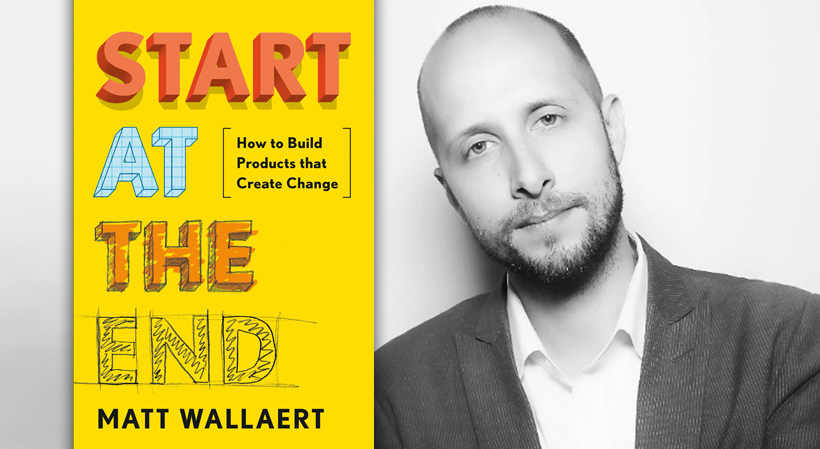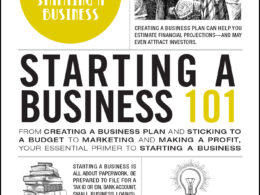Many entrepreneurs focus first on building products and then finding a problem for their products to solve. That’s a mistake, according to Matt Wallaert, author of “Start at the End: How to Build Products that Create Change.”
Wallaert is a behavioral scientist turned serial entrepreneur. He co-founded Churnless, a product consultancy that uses behavioral technology and psychology to change human behavior, and GetRaised, a step-by-step guide for women to get a pay raise, among other ventures. Currently, he works at Clover Health as the healthcare industry’s first Chief Behavioral Officer.
We talked with Wallaert to find out how founders can shift to problem-first thinking and why this customer-centered approach is essential for success.
Related: Where Do Great Ideas Come From? Examining the Design Thinking Behind Fitbit
The following conversation has been edited for clarity and brevity.
StartupNation: Why do you think that so many companies cling to the more traditional model of creating sexy products, rather than ones that create behavioral change?
Matt Wallaert: One, I think it fits with the way that we present the narrative of companies often. The narrative of many startups is, “So-and-so was doing something, and then they had a brilliant idea.” That’s a very solution-focused, product-focused, idea-focused narrative of how and why things get created.
We almost never tell the narrative of, “Mack was thinking really hard about how to get people to blank. Then he did X, Y and Z to figure out how to get people to blank.”
We often present this story from a solution-perspective, not a problem-perspective. But if you talked to top entrepreneurs, most of the time, they are relentlessly problem-focused. They know what behavior they want to create, and then they use that to back into a product.
StartupNation: Any tips on how entrepreneurs can shift their thinking toward problems rather than products?
Matt Wallaert: I think the whole point here is to push yourself to really articulate, what is the behavior that you’re trying to change? One of the most common and consistent questions I ask people when they pitch me startups is, “What is true in the world if you are successful? What is physically, observably true?”
Very often, people struggle with that. They’ll either tell me, “People will feel that way or believe a thing.” That’s not a behavior. I don’t know feelings or beliefs. I only know behaviors. The other thing is, they’ll say, “Everybody will use my thing.” Mere usage of a thing, while it is, in fact, a behavior, is motivating to no one. My natural question is going to be, “Well, why aren’t they already X-ing?” Right?
You need good, clear, triangulated feedback that people have an existing desire to X and there are clear reasons they’re not already X-ing that are solved by what you’re building. Then and only then can you be in the right place.
People are just in too much of a rush. As with bias, rushing is our great downfall. My team will tell you I’m relentlessly focused on pushing things forward. But people try and get progress on the wrong kinds of things. They’re too busy trying to raise money to figure out do they actually have something?
You’ve got to demonstrate to me that you have something before you move on to the next steps of entrepreneurship.
StartupNation: What companies do you think are nailing behavior change?
Matt Wallaert: From an investment perspective, Netflix is great example. Meetup’s a good example of a company that sort of plateaued, but was able to very successfully change people’s behavior. They boosted the behavior they wanted, because they were very clear about the behavior they wanted. They believe very powerfully that the behavior of interest to them was physically getting people together in-person.
StartupNation: Not all behavior change is positive. How does that fit into your model?
Matt Wallaert: Science is not immoral or moral. It’s simply amoral. The method that I lay out is one that could be used to change any behavior. I think Uber’s behavioral science team has shown a shocking lack of morality, in terms of the behavioral science that they choose to do, keeping drivers on the road longer.
People need to be reminded that if you use (science) for bad ends, there are people who will fight back. We can harness the power of science to disrupt traditional economies and traditional power structures. Behavioral science is one of our best shots at disrupting what has been a tremendously inequitable and pervasive over the last hundred years.
StartupNation: How do you think behavioral science will disrupt that?
Matt Wallaert: Bias and other kinds of power structures are just a pattern of behaviors. I’ve built product after side project, after side project to destroy this.
For instance, GetRaised. Prior to it, every other notion was on, “you should just want it more.” It’s about women asking for raises. It’s about getting women to want to do it more.
We fundamentally believe women want to be wealthy and want to have power and want to be paid fairly and those sorts of things, but they are statistically less likely to take equity-based offers. Let’s translate equity into salaries, so that they’re more likely to accept equity-based offers and make one-to-one comparisons.
I was working on a hack today, where I was talking to somebody, a company in South Africa, about how to get more underrepresented speakers on stage. Off the cuff, I said, “What if you just made a little something that said, ‘Instead of inviting me, here are five people you can invite, who aren’t me, who add diversity.’”
I’m editing my webpage right now to add, “OK, here are some people you could invite, instead of me, who are really great speakers on the topics that I tend to speak about.”
Sign Up: Receive the StartupNation newsletter!
“Start at the End: How to Build Products that Create Change” is available now wherever books are sold and can be purchased via StartupNation.com.






